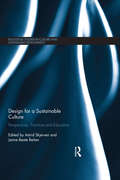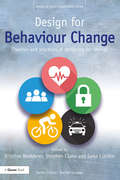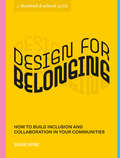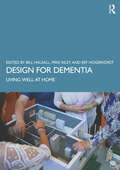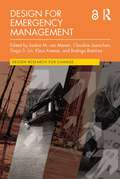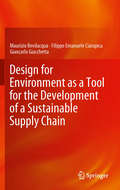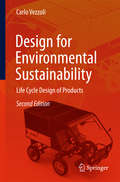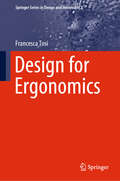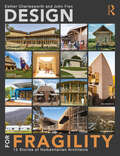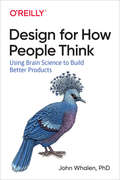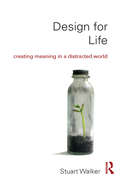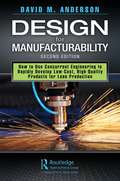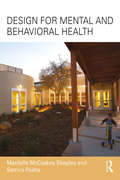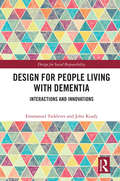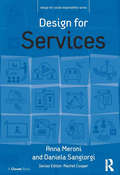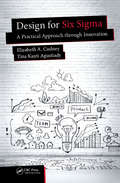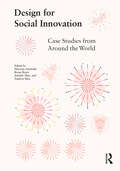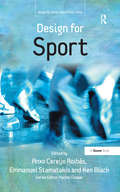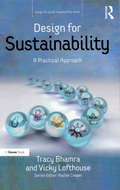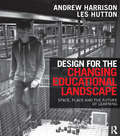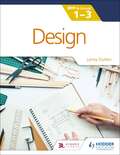- Table View
- List View
Design Firms Open for Business
by Steven Heller Lita TalaricoWhile many young designers perceive a design studio to be little more than a table and computer, the majority of businesses consider the physical locale and architectural surroundings of a firm to be as important as the work that is produced. Design Firms Open for Business is a firsthand look inside studios and offices, both large and small, from all over the world. The inner workings of more than 40 different-sized and variously focused design establishments are explored, offering keen insights into firms working on everything from two- to three-dimensional projects. Designers reveal their thinking about a broad spectrum of important issues, ranging from the names they selected to the underlying philosophy of their practices to the business models they employ. Profusely illustrated with photos of both specific work and working environments, this book provides a unique blend of analysis and biography rolled into one. Each firm is placed in the spotlight, providing an array of successful models to consider by those who are looking to start their own ventures and by those experienced professionals looking for fresh ideas.
Design for a Better Future: A guide to designing in complex systems
by John Body Nina TerreyThe world we live in is increasingly complex. It throws up complex problems. This book is about tackling them. <P><P> At ThinkPlace, we’ve pioneered the application of design thinking to complex challenges like climate change, family violence and global malnutrition. We work globally with governments, organisations and communities using a methodology – the Design System™ outlined in this book – that has been developed over more than a decade. <P><P> We bring together different voices and help them to create better futures. If you’re one of those voices, or would like to be, this book is for you. It’s part roadmap, part instruction manual, but mostly it’s a clarion call for a new way of doing things: tackling the world’s biggest problems in a way that brings people together and produces positive, lasting change.
Design for a Sustainable Culture: Perspectives, Practices and Education (Routledge Studies in Culture and Sustainable Development)
by Astrid Skjerven Janne ReitanAs culture is becoming increasingly recognised as a crucial element of sustainable development, design competence has emerged as a useful tool in creating a meaningful life within a sustainable mental, cultural and physical environment. Design for a Sustainable Culture explores the relationship between sustainability, culture and the shaping of human surroundings by examining the significance and potential of design as a tool for the creation of sustainable development. Drawing on interdisciplinary case studies and investigations from Europe, North America and India, this book discusses theoretical, methodological and educational aspects of the role of design in relation to human well-being and provides a unique perspective on the interface between design, culture and sustainability. This book will appeal to researchers as well as postgraduate and undergraduate students in design and design literacy, crafts, architecture and environmental planning, but also scholars of sustainability from other disciplines who wish to understand the role and impact of design and culture in sustainable development.
Design for Behaviour Change: Theories and practices of designing for change (Design for Social Responsibility)
by Kristina Niedderer Stephen Clune Geke LuddenDesign impacts every part of our lives. The design of products and services influences the way we go about our daily activities and it is hard to imagine any activity in our daily lives that is not dependent on design in some capacity. Clothing, mobile phones, computers, cars, tools and kitchenware all enable and hold in place everyday practices. Despite design’s omnipresence, the understanding of how design may facilitate desirable behaviours is still fragmented, with limited frameworks and examples of how design can effect change in professional and public contexts. This text presents an overview of current approaches dedicated to understanding how design may be used intentionally to make changes to improve a range of problematic social and environmental issues. It offers a cross-disciplinary and cross-sectoral overview of different academic theories adopted and applied to design for behaviour change. The aim of the volume is twofold: firstly, to provide an overview of existing design models that integrate theories of change from differing scientific backgrounds; secondly, to offer an overview of application of key design for behaviour change approaches as used across case studies in different sectors, such as design for health and wellbeing, sustainability, safety, design against crime and social design. Design for Behaviour Change will appeal to designers, design students and practitioners of behavioural change.
Design for Belonging: How to Build Inclusion and Collaboration in Your Communities (Stanford d.school Library)
by Susie Wise Stanford d.schoolA practical, illustrated guide to using the tools of design to create feelings of inclusion, collaboration, and respect in groups of any type or size—a classroom, a work team, an international organization—from Stanford University's d.school.&“This is a beautiful book. Wise has applied the gift and imagination and lenses of the d.school to one of our most precious questions: how to create belonging.&”—Priya Parker, author of the Art of Gathering and host of the New York Times podcast Together ApartBelonging brings out the best in everyone. Whether you&’re a parent, teacher, community organizer, or leader of any sort, your group is unlikely to thrive if the individuals don&’t feel welcomed, included, and valued for who they are.The good news is that you can use design to create feelings of inclusion in your organization: rituals that bring people together, spaces that promote calm, roles that create a sense of responsibility, systems that make people feel respected, and more. You can&’t force feelings, but in Design for Belonging, author and educator Susie Wise explains how to use simple levers of design to set the stage for belonging to emerge. For example, add moveable furniture to a meeting space to customize for your group size; switch up the role of group leader regularly to increase visibility for everyone; or create a special ritual for people joining or leaving your organization to welcome fresh perspectives and honor work well done.Inspiration and stories from leaders and scholars are paired with frameworks, tools, and tips, providing an opportunity to try on different approaches. By the end of the book, you&’ll be able to spot where a greater sense of belonging is needed and actively shape your world to cultivate it—whether it&’s a party, a high-stakes meeting, or a new national organization.
Design for Dementia: Living Well at Home
by Bill Halsall Michael Riley Eef HogervorstDesign for Dementia is written by an interdisciplinary team of professionals and academics whose aim is to present lessons learnt from the Dementia Demonstration House at the Building Research Establishment’s Innovation Park. Known as Chris and Sally’s House, the project represents a unique opportunity to show in practice what can be done to assist people living with dementia to continue to live at home and as part of the community with as much independence as possible. This book presents evidence based practical design guidance backed up by over 15 combined years of research by experienced professional designers.Beginning with an introduction which provides the background to the global dementia epidemic to allow readers to gain a better understanding of the issues they must consider, the book then discusses how good design principles, planning and construction standards can be used to effectively respond to the dementia crisis. The detailed findings from research using Chris and Sally’s House are presented and discussed, along with practical examples and success stories ranging from simple design features to the more complex use of sensors and automated ventilation.The hope is that readers can apply the lessons learnt from Chris and Sally’s House to successfully integrate solutions into the design of new or refurbished housing for the elderly and also that the tools and insights shared will inform the wider context of good housing design, as well as the spectrum of constraints and design standards which often apply. This book is important reading for architects, designers, engineers and project managers, but also anyone with an interest in learning about practical solutions to aid those with dementia to live well at home.
Design for Emergency Management (Design Research for Change)
by Saskia M. van Manen Claudine Jaenichen Klaus Kremer Tingyi S. Lin Rodrigo RamírezThrough a combination of theory, practice, and a range of interdisciplinary case studies, this book expands how we define and think about the critical role and relationship between design and emergencies. This role extends far beyond aesthetics: the book highlights the urgency of ensuring that a wide range of stakeholders and a diverse representation of the public comes together to work towards preventing disasters. Design in the context of disasters, such as earthquakes, hurricanes, flooding and (wild) fires, provides new ways of looking at challenges. It contributes methods to actively engage communities in managing and minimizing disaster risk. Contributors present the latest research on how (collaborative) design and design thinking contribute to the development of processes and solutions to increase disaster literacy and decrease disaster risk for individuals and entire communities. Chapters highlight applied research and implementation of design and design thinking before, during, and after emergencies, resulting in a set of design guidelines derived from best practice. The book will be of interest to scholars and practitioners in emergency management, product and service design, strategic design, design research, co-design, social design, design for change, and human-centered design.
Design for Environment as a Tool for the Development of a Sustainable Supply Chain
by Maurizio Bevilacqua Filippo Emanuele Ciarapica Giancarlo GiacchettaEnvironmental Design is becoming an increasingly significant agenda for many manufacturing companies and yet there is no standard to their approaches, strategies or their levels of execution. Applying Design for Environment (DfE) methodologies to develop a more sustainable supply chain has formed procedures and techniques which allow designers to integrate these methods with environmental supply chain management. Design for Environment as a Tool for the Development of a Sustainable Supply Chain aims to define relevant target specifications for a product throughout its life cycle; from conception and design to the end of its operating life. Be considering this new approach to the supply chain, environmental responsiveness can work in tandem with sounds business management. The usual focus on suppliers, manufacturers and customers is expanded in Design for Environment as a Tool for the Development of a Sustainable Supply Chain to include stakeholders such as government bodies and recycling companies. The influence of these additional groups is analyzed alongside concepts such as: Product life cycle development aimed at environmental impact minimization; Supplier selection and management based on environmental criteria; and Marketing and communication choices which increase the value of environmentally sensitive products. By including several case studies alongside theoretical topics, Design for Environment as a Tool for the Development of a Sustainable Supply Chains acts as a foundation for professionals across the supply chain, from industrial designers to marketing and sales departments, who are involved in environmental issues.
Design for Environmental Sustainability: Life Cycle Design Of Products
by Carlo Arnaldo VezzoliThis volume is a technical and operative contribution to the United Nations "Decade on Education for Sustainable Development" (2005-2014), aiding the development of a new generation of designers, responsible and able in the task of designing environmentally sustainable products. The book provides a comprehensive framework and a practical tool to support the design process. This is an important text for those interested in the product development processes.
Design for Ergonomics (Springer Series in Design and Innovation #2)
by Francesca TosiThis book focuses on the global quality of the design of systems that people interact with during their work activities and daily lives; a quality that involves the globality of people’s experience – physical, sensory, cognitive and emotional. It presents a concise and structured overview of the ergonomic approach to planning, and of methodological and operational tools from ergonomic research that can more directly and concretely contribute to the design process. The book also explores physical ergonomics and cognitive ergonomics, which are essential components of design culture. The final section addresses the main design problems and intervention criteria regarding the design of environments, products and equipment, as well as the design of communication, training and learning interface systems based on digital technologies. The book is chiefly intended for designers and anyone interested in the methods, tools and opportunities for in-depth analysis and development that ergonomics can offer regarding the conception, production and testing of products, environments and services, whether physical or virtual. It also offers a learning resource for professionals and students in Industrial Design and Planning.
Design for Fragility: 13 Stories of Humanitarian Architects
by Esther Charlesworth John FienThe demand is now urgent for architects to respond to the design and planning challenges of rebuilding cities and landscapes being destroyed by civil conflict, (un)natural disasters, political instability, and poverty. The number of people fleeing their homes and being displaced by such conflict now totals almost 100 million. Despite the massive human and physical costs of these crises, the number of architects, planners, and landscape architects equipped to work with disaster and development professionals in rebuilding in the aftermath of conflict, floods, fires, earthquakes, typhoons, and tsunamis remains chronically low. Design for Fragility expands the nascent, but rapidly growing field of humanitarian architecture by exploring 13 design responses to such conflict and displacement across 11 countries, including Australia, Bangladesh, Fiji, India, Iran, Pakistan, and the USA. Linked to this displacement is the systemic poverty that often lingers from previous colonial territories and eras, in which many of the featured projects in the book are located. This book follows Charlesworth’s Humanitarian Architecture: 15 Stories of Architects Working After Disasters (Routledge 2014), which analysed the role for architects in exercising ‘spatial agency’ while designing shelter and settlement projects for communities after conflict and disaster. Since that time, the humanitarian architecture movement has expanded globally with the prominence of design agencies including the MASS Design Group and Architecture Sans Frontières (ASF) International. Design for Fragility analyses this role of spatial agency in architecture by addressing diverse conditions of fragility across 13 built projects – from refugee housing in Uganda and an orphanage for teenage girls in Iran to a residential centre in Northern Australia for people with acquired brain injury. Each of the projects profiled in this book explore: The experiences and perceptions of fragility – or precarity – that provided a design challenge and directed the particular spatial response. The specific typology of the project, whether that be a housing, health, children’s, or a First Nations project. The personal values that influenced the architects to work on humanitarian/community projects and how consultation occurred with diverse and often contested project stakeholders. The experiences of the design team as well as project managers, occupants, and donors of the built project, exploring what they deemed successful about the project, and what, if any, were its limitations. Beautifully designed with over 150 illustrations, this practical and inspiring book is for architects, landscape architects, design educators, humanitarian and development aid agencies that are involved, or seeking to be part, of future disaster mitigation and reconstruction strategies and projects, globally.
Design for How People Think: Using Brain Science to Build Better Products
by John WhalenUser experience doesn’t happen on a screen; it happens in the mind, and the experience is multidimensional and multisensory. This practical book will help you uncover critical insights about how your customers think so you can create products or services with an exceptional experience.Corporate leaders, marketers, product owners, and designers will learn how cognitive processes from different brain regions form what we perceive as a singular experience. Author John Whalen shows you how anyone on your team can conduct "contextual interviews" to unlock insights. You’ll then learn how to apply that knowledge to design brilliant experiences for your customers.Learn about the "six minds" of user experience and how each contributes to the perception of a singular experienceFind out how your team—without any specialized training in psychology—can uncover critical insights about your customers’ conscious and unconscious processesLearn how to immediately apply what you’ve learned to improve your products and servicesExplore practical examples of how the Fortune 100 used this system to build highly successful experiences
Design for Life: Creating Meaning in a Distracted World
by Stuart WalkerStuart Walker’s design work has been described as life-changing, inspiring, disturbing and ferocious. Drawing on an extraordinarily diverse range of sources and informed by creative practice, Design for Life penetrates to the heart of modern culture and the malaise that underlies today’s moral and environmental crises. The author argues that this malaise is deep-seated and fundamental to the modern outlook. He shows how our preoccupation with technological progress, growth and the future has produced a constricted view of life – one that is both destructive and self-reinforcing. Based on over twenty-five years of scholarship and creative practice, he demonstrates the vital importance of solitude, contemplation, inner growth and the present moment in developing a different course – one that looks squarely at our current, precarious situation while offering a positive, hopeful way forward – a way that is compassionate, context-based, human scale, ethically motivated and critically creative. Design for Life is an intensely original contribution that will be essential reading for design practitioners and students. Written in a clear, accessible style, it will also appeal to a broader readership, especially anyone who is concerned with contemporary society’s rising inequalities and environmental failings and is looking for a more constructive, balanced and thoughtful direction.
Design for Manufacturability: How to Use Concurrent Engineering to Rapidly Develop Low-Cost, High-Quality Products for Lean Production, Second Edition
by David M. AndersonAchieve any cost goals in half the time and achieve stable production with quality designed in right-the-first-time. Design for Manufacturability: How to Use Concurrent Engineering to Rapidly Develop Low-Cost, High-Quality Products for Lean Production is still the definitive work on DFM. This second edition extends the proven methodology to the most advanced product development process with the addition of the following new, unique, and original topics, which have never been addressed previously. These topics show you how to: Cut cost from 1/2 to 1/10 in 9 categories—with ways to remove that much cost from product charges and pricing Commercialize innovation—starting with Manufacturable Research and learning from the new section on scalability, you will learn how to design products and processing equipment to scale quickly to any growth levels Design product families that can be built "on-demand" in platform cells that also "mass customize" products to-order Make Lean production easier to implement with much more effective results while making build-to-order practical with spontaneous supply chains and eliminating forecasted inventory by including an updated chapter on "Designing Products for Lean Production" The author’s 30 years of experience teaching companies DFM based on pre-class surveys and plant tours is the foundation of this most advanced design process. It includes incorporating dozens of proven DFM guidelines through up-front concurrent-engineering teamwork that cuts the time to stable production in half and curtails change orders for ramps, rework, redesign, substituting cheaper parts, change orders to fix the changes, unstable design specs, part obsolescence, and late discovery of manufacturability issues at periodic design reviews. This second edition is for the whole product development community, including: Engineers who want to learn the most advanced DFM techniques Managers who want to lead the most advanced product development Project team leaders who want to immediately apply all the principles taught in this book in their own micro-climate Improvement leaders and champions who want to implement the above and ensure that the company can design products and versatile processing equipment for low-volume/high-mix product varieties Designing half to a tenth of cost categories can avoid substituting cheap parts, which degrades quality, and encourages standardization and spontaneous supply chains, which will encourage Lean initiatives. Using cellular manufacturing to shift production between lines for mixed production of platforms and build-to-order to offer the fastest order fulfillment can beat any competitors’ delivery time.
Design for Mental and Behavioral Health
by Mardelle McCuskey Shepley Samira PashaStudies confirm that the physical environment influences health outcomes, emotional state, preference, satisfaction and orientation, but very little research has focused on mental and behavioural health settings. This book summarizes design principles and design research for individuals who are intending to design new mental and behavioural health facilities and those wishing to evaluate the quality of their existing facilities. The authors discuss mental and behavioural health systems, design guidelines, design research and existing standards, and provide examples of best practice. As behavioural and mental health populations vary in their needs, the primary focus is limited to environments that support acute care, outpatient and emergency care, residential care, veterans, pediatric patients, and the treatment of chemical dependency.
Design for People Living with Dementia: Interactions and Innovations (Design for Social Responsibility)
by Emmanuel Tsekleves John KeadyThere were an estimated 50 million people worldwide living with dementia in 2017 and this number will almost double every 20 years, reaching 75 million in 2030. Design has significant potential to contribute to managing this global concern. This book is the first to synthesise the considerable research and projects in dementia and design. Design interactions is a new way of considering how we can improve the relationship between people, products, places and services and of course technology trends, such as the ‘internet of things’, offer great opportunities in providing new ways to connect people with services and products that can contribute to healthier lifestyles and mechanisms to support people with acute and chronic conditions. In light of this, the book explores the contribution and future potential of design for dementia through the lens of design interactions, such as people, contexts, material and things. Design for People Living with Dementia is a guide to this innovative and cutting-edge field in healthcare. This book is essential reading for healthcare managers working to provide products, services and care to people with dementia, as well as design researchers and students. .
Design for Secure Residential Environments (Chartered Institute of Building)
by Steve Crouch Henry Shaftoe Roy FlemingThere is currently a great deal of interest in crime prevention and how it can be reduced through better design. Design for a Secure Residential Environment provides the framework on which the risk of crime can be reduced through sensible design of the vulnerable parts of houses, community buildings and small commercial premises and the environment immediately surrounding the buildings.This book looks at how buildings should be assessed for security measures. It then looks at the design of external and communal areas, how lighting can improve security and then covers methods of making doors and windows secure. It describes various methods of electronic security and concludes with a chapter on how to plan and implement suitable security measures.
Design for Services: Key Issues And New Directions (Design for Social Responsibility)
by Anna Meroni Daniela SangiorgiIn Design for Services, Anna Meroni and Daniela Sangiorgi articulate what Design is doing and can do for services, and how this connects to existing fields of knowledge and practice. Designers previously saw their task as the conceptualisation, development and production of tangible objects. In the twenty-first century, a designer rarely 'designs something' but rather 'designs for something': in the case of this publication, for change, better experiences and better services. The authors reflect on this recent transformation in the practice, role and skills of designers, by organising their book into three main sections. The first section links Design for Services to existing models and studies on services and service innovation. Section two presents multiple service design projects to illustrate and clarify the issues, practices and theories that characterise the discipline today; using these case studies the authors propose a conceptual framework that maps and describes the role of designers in the service economy. The final section projects the discipline into the emerging paradigms of a new economy to initiate a reflection on its future development.
Design for Six Sigma: A Practical Approach through Innovation (Continuous Improvement Series)
by Elizabeth A. Cudney Tina Kanti AgustiadyDesign for Six Sigma (DFSS) is an innovative continuous improvement methodology for designing new products, processes, and services by integrating Lean and Six Sigma principles. This book will explain how the DFSS methodology is used to design robust products, processes, or services right the first time by using the voice of the customer to meet Six Sigma performance. Robust designs are insensitive to variation and provide consistent performance in the hands of the customer. DFSS is used to meet customer needs by understanding their requirements, considering current process capability, identifying and reducing gaps, and verifying predictions to develop a robust design. This book offers: Methodology on how to implement DFSS in various industries Practical examples of the use of DFSS Sustainability utilizing Lean Six Sigma techniques and Lean product development Innovative designs using DFSS with concept generation Case studies for implementing the DFSS methodology Design for Six Sigma (DFSS) enables organizations to develop innovative designs. In order to redesign an existing process or design a new process, the success is dependent on a rigorous process and methodology. DFSS ensures that there are minimal defects in the introduction of new products, processes, or services. The authors have compiled all of the tools necessary for implementation of a practical approach though innovation.
Design for Social Innovation: Case Studies from Around the World
by Mariana Amatullo Bryan Boyer Jennifer May Andrew SheaThe United Nations, Australia Post, and governments in the UK, Finland, Taiwan, France, Brazil, and Israel are just a few of the organizations and groups utilizing design to drive social change. Grounded by a global survey in sectors as diverse as public health, urban planning, economic development, education, humanitarian response, cultural heritage, and civil rights, Design for Social Innovation captures these stories and more through 45 richly illustrated case studies from six continents. From advocating to understanding and everything in between, these cases demonstrate how designers shape new products, services, and systems while transforming organizations and supporting individual growth. How is this work similar or different around the world? How are designers building sustainable business practices with this work? Why are organizations investing in design capabilities? What evidence do we have of impact by design? Leading practitioners and educators, brought together in seven dynamic roundtable discussions, provide context to the case studies. Design for Social Innovation is a must-have for professionals, organizations, and educators in design, philanthropy, social innovation, and entrepreneurship. This book marks the first attempt to define the contours of a global overview that showcases the cultural, economic, and organizational levers propelling design for social innovation forward today.
Design for Sport (Design for Social Responsibility)
by Anxo Cereijo Roibás Emmanuel StamatakisDesign for Sport shows how socially responsible design can contribute to make sport practice widespread in the general population including disadvantaged and hard-to-reach groups, and those that have been traditionally excluded such as the elderly, disabled people, those living in deprived areas and from lower socioeconomic strata plus certain minority ethnic and religious groups. Contributions from around the world provide compelling case studies and an international perspective. While the main benefit from expanding sports practice in developed societies would be reduction of chronic disease rates and social inclusion, in the developing world where political instability and conflict are more common, the authors look at how sport can have other functions, such as a means of post-disaster relief. They discuss how Participatory Design (PD) techniques and appropriate ethnographies can be implemented in order to better understand users' needs and requirements as in the case of Paralympic sport where the increased sophistication of equipment used has evolved to meet the demands of the athletes. Reflecting the multi-disciplinary and cross-disciplinary nature of design for sport, the book also features case studies that look at environmental design to improve sport accessibility, social wellbeing, economic development and environmental sustainability.
Design for Sustainability: A Practical Approach (Design for Social Responsibility)
by Tracy Bhamra Vicky LofthouseDesign for Sustainability is a practical approach to design which focuses on the challenges and issues faced by those designing consumer products in the 21st Century. It is written from a design perspective and aimed at both professional and student industrial and product designers, and those involved in managing design. The book begins by summarising the historical and current issues of the environmental debate in the context of sustainable product development, highlighting the benefits gained from considering the impact on the environment and issues of sustainability when designing. The authors answer the questions: What is sustainable product development and why is it important? What are the main drivers of sustainable product development? They explain how design can help to control human impact on the environment by not only minimising pollution, waste, energy use and use of scarce resources, but also by thinking outside the box to create systems and services that can reduce the number of products manufactured. The aim is to put sustainable development within a commercial context and introduce a new focus for design. Design for Sustainability outlines and assesses the methods, tools and techniques available to designers, both for design innovation and design improvement. A wide range of case studies are presented across a number of product sectors including electrical goods, IT and furniture. Initially they demonstrate product improvement and redesign, examples include those that reduce waste, pollution and energy consumption, designing for recycling and reuse of parts. Further examples are then provided exemplifying the more radical approach of system and service design. The final section takes the reader through a whole sustainable design project from start to finish, from brief to manufacture. References and sources of information are also included.
Design for the Changing Educational Landscape: Space, Place and the Future of Learning
by Andrew Harrison Les HuttonThe whole landscape of space use is undergoing a radical transformation. In the workplace a period of unprecedented change has created a mix of responses with one overriding outcome observable worldwide: the rise of distributed space. In the learning environment the social, political, economic and technological changes responsible for this shift have been further compounded by constantly developing theories of learning and teaching, and a wide acceptance of the importance of learning as the core of the community, resulting in the blending of all aspects of learning into one seamless experience. This book attempts to look at all the forces driving the provision and pedagogic performance of the many spaces, real and virtual, that now accommodate the experience of learning and provide pointers towards the creation and design of learning-centred communities. Part 1 looks at the entire learning universe as it now stands, tracks the way in which its constituent parts came to occupy their role, assesses how they have responded to a complex of drivers and gauges their success in dealing with renewed pressures to perform. It shows that what is required is innovation within the spaces and integration between them. Part 2 finds many examples of innovation in evidence across the world – in schools, the higher and further education campus and in business and cultural spaces – but an almost total absence of integration. Part 3 offers a model that redefines the learning landscape in terms of learning outcomes, mapping spatial requirements and activities into a detailed mechanism that will achieve the best outcome at the most appropriate scale. By encouraging stakeholders to creating an events-based rather than space-based identity, the book hopes to point the way to a fully-integrated learning landscape: a learning community.
Design for the IB MYP 1-3: By Concept
by Lenny DuttonEnsure your students navigate the MYP framework with confidence using a concept-driven and assessment-focused approach to Design, presented in global contexts. - Develop conceptual understanding with key concepts and related concepts, set in global contexts, at the heart of each chapter. -Prepare for every aspect of assessment using support and tasks designed by an experienced educator. - Extend learning through research projects and interdisciplinary opportunities. - Apply global contexts in meaningful ways with an internationally-minded perspective. - Develop practical and creative-thinking skills to solve design problems with a statement of inquiry in each chapter. - Confidently cover the framework with chapters covering digital, product and combined design.
Design for the IB MYP 1-3: By Concept
by Lenny DuttonEnsure your students navigate the MYP framework with confidence using a concept-driven and assessment-focused approach to Design, presented in global contexts. - Develop conceptual understanding with key concepts and related concepts, set in global contexts, at the heart of each chapter. -Prepare for every aspect of assessment using support and tasks designed by an experienced educator. - Extend learning through research projects and interdisciplinary opportunities. - Apply global contexts in meaningful ways with an internationally-minded perspective. - Develop practical and creative-thinking skills to solve design problems with a statement of inquiry in each chapter. - Confidently cover the framework with chapters covering digital, product and combined design.


